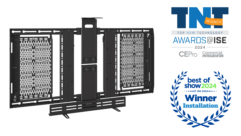AV Pros Mastering Fiber Basics
Mar 28, 2007 8:00 AM
AV professionals eager to seize the advantages of fiber optics for transporting high-quality audio and video signals are getting help from many directions these days. In particular, it’s becoming easier all the time to become well versed in the basics of fiber, and manufacturers are greatly simplifying some processes that used to be seen as dauntingly complex.
“One of the myths regarding fiber is that it is difficult to install and maintain,” says Jim Jachetta, senior vice president of sales and marketing at MultiDyne, in a chapter on fiber optics that he wrote for a forthcoming National Association of Broadcasters Engineering Handbook. “This may have been true in the early days, but now it is as simple to terminate an optical fiber with a connector as it is to install a connector on coax. Fiber-optic termination kits are now available that require no epoxy and special polishing. Simple cable-stripping tools are used, similar to those used for copper coax, to prepare the fiber for termination. Epoxy-free connectors are available to terminate both multimode and single-mode fiber-optic cable. The connectors are already pre-polished. No polishing equipment is needed.”
The process of polishing fibers for good connections used to be viewed as a craft. Don Hosmer, national sales manager at Broadata, suggests a different view. “There are connector manufacturers that have created epoxyless connector systems,” he says, “but even standard epoxy connectors are easy. Anyone can be taught how to polish in 10 minutes. Polishing consists of stripping the fiber to its glass, cleaving, connectorizing, and polishing with figure-eight hand movements.”
This polishing process uses a series of ever-finer diamond-impregnated lapping films, “basically fancy sand paper,” according to Hosmer, and takes a few minutes per connection.
Installation of fiber is also getting easier, although fiber proponents say its light weight and flexibility have always been a big plus in fitting fiber lines into tight spaces. “I tell anyone that is new to fiber to consider buying and installing pre-made fiber cabling, which is designed for pulling, so as not to have to be an expert at termination. However,” he adds, “with the advent of new connectors, field termination is easy and quick.”
AV pros are also expanding their familiarity with different types of fiber and the suitability of each type for particular AV applications. In general, Jachetta points out, fiber cables come in two basic types: single-mode and multimode. A mode, in fiber terms, is simply a single light path.
Multimode fibers have a larger core and can, in theory, accommodate a very large number of separate light paths. The result, though, is a shotgun effect that makes multimode most suitable for relatively short-haul transport, up to about 5km.
Single-mode fiber comes with higher equipment costs but delivers more flexibility in wavelengths, virtually unlimited bandwidth, smaller optical losses, and capability to carry a signal about 20km. Long-haul lasers are available, Jachetta says, that can boost this transport distance to 80km to 100km.
Optical multiplexing permits a single fiber to carry multiple signals, and time division multiplexing allows many video channels to be combined into a high-speed stream. “When optical and time division multiplexing are combined,” Jachetta says, “up to 144 uncompressed video channels can travel over one fiber.”
AV specialists looking for fiber education resources have plenty to choose from, Hosmer notes. “There is no ‘fiber bible’ to my knowledge, but a web search can turn up any number of good tutorials.”










